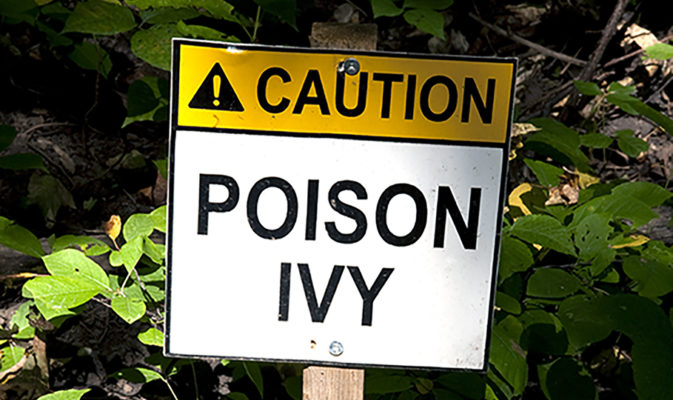Growing up you may have heard the saying, “leaves of three, let them be.” It’s an easy way to remember how to recognize poison ivy or oak plants – and it’s an important thing to teach kids as they’re exploring outdoors or helping with yard chores.
This time of year pediatric and family practitioners – and in serious cases, dermatology practitioners – begin to see patients who have contact dermatitis caused by contact with poison ivy, oak or sumac. It is itchy, painful and the blisters can be worrisome if you don’t know what it is. There is also a lot of misinformation and misunderstanding about these plants and the reaction they cause. The FAQ below has everything you need to know:
- What is contact dermatitis? “Contact Dermatitis” is a broad term comprising a group of rashes (or skin changes) caused by contact with a foreign substance.
- What does contact dermatitis caused by poison ivy, oak or sumac look like? Contact with poison ivy, oak, or sumac plants can cause red, swollen skin, blisters, and severe itching.
- Why do these plants cause contact dermatitis? These plants produce an oily substance called urushiol, which causes an allergic reaction in most people.
- How does the urushiol get on the skin of humans? The urushiol will transfer directly to skin if it contacts the plant. Additionally, urushiol can stick to almost anything (clothing, pet fur, hair, a water hose, a gardening tool), and can be transferred to skin from that object.
- Is it true that some people do not react to poison ivy? It is believed that about 70% of the US population would acquire this contact dermatitis if exposed to the offending leaves, stems, and roots (Paller et al).
- How quickly does the reaction occur? The rash usually appears in sensitized individuals (those considered allergic) within 1-3 days after exposure. However, in highly sensitized patients, the rash can appear within 8 hours of exposure.
- Why is the rash severe for some people and mild for others? The unique differences in presentation, onset, and symptoms are likely due to the degree of exposure, individual sensitivity, and variation in the activity of the body region affected. Due to the inflammatory nature of this rash, when the face and genital regions are affected, pain and other symptoms can be heightened so we generally recommend prompt medical care when these areas are involved.
- What should I do if I think a member of my family has been exposed to one of these plants? Immediately after contact, and also at the first sign of an allergic reaction, wash your skin with soap and warm water (using friction to remove the oils from the skin). Possible vehicles for cross-contamination (clothing, pet fur, hair, a water hose, a gardening tool) should be thoroughly cleaned as well.
- Is it ok to treat poison ivy-related contact dermatitis at home, and if so, how should it be treated? For mild rash, cool showers, calamine lotion, hydrocortisone cream, and antihistamines may help soothe the itching. Since the rash is caused by the oil (from poison ivy, oak, or sumac), the oil needs to be carefully and uniformly removed from the skin to prevent transmission to other areas of the body.
- Is the rash contagious? It is a common myth that the fluid content of blisters and/or the rash itself is contagious. This is simply not true as once the oil is removed the rash cannot be spread to other parts of the body of the individual affected or to others (Paller et al).
- What are indications that the rash needs to be evaluated by a medical professional? If you have a severe reaction or if your eyes, face, or genital area is involved, you should seek urgent care from a medical provider. At this time, a prescription may be needed to reduce itching and swelling.
- What treatments might a medical professional prescribe for this type of contact dermatitis? Common prescriptions used include mid-high potency topical steroids, antihistamines, and oral corticosteroids.
- How long should it take for the rash to go away? Most cases of contact dermatitis to poison ivy, oak, and sumac resolve slowly within 1-3 weeks.
- Can poison ivy spread in the blood system? No, but commonly in the fall, when brush or leaves are burned, the oils can be aerosolized and transmitted by smoke to exposed surfaces, nasal passages, the mouth, the esophagus, and trachea. This can present as widespread facial swelling and, rarely, can cause difficulty breathing. To reiterate, once the face swells or facial rash is worsening, medical care should be sought out so as to avoid more serious complications from this common, usually non-serious medical condition.
- What can I do to keep my family safe around these plants? Use “leaves of three, let them be” as a basis to teach your whole family to avoid these plants. Learning how to recognize and avoid poison ivy or oak (whose leaves also grow in threes) is considered the best protection against the associated rash. Other strategies include wearing long-sleeves and long pants tucked into socks and boots when hiking or spending time in regions where these plants grow. There is a readily-available protective barrier lotion containing bentoquatam (called Ivy Block) that can be applied as directed to provide a barrier against the offending oils prior to potential contact with them. Bentoquatam works by preventing the plant oils from penetrating the skin.
- Where and how do these plants grow? The poison ivy plant shows three leaves notched at the edge. It grows extravagantly as a tall shrub or woody rope-like vine. It can stand alone, grow among grasses and on trees or fences. Poison oak grows as a shrub and is most indigenous to the Western United States. Poison sumac grows as a shrub or tree, not a vine. It has leaves of two in pairs along a central stem with a single leaf at the end/top. Poison sumac is relatively uncommon and grows less widespread as it is found in woody, swampy areas primarily east of the Mississippi River (Paller et al).
REFERENCE:
***Paller, A. & Mancini, A.J. (2011). Hurwitz’s clinical pediatric dermatology: A textbook of skin disorders of childhood and adolescence. (4th ed.). Edinburgh, London, New York, Oxford, Philadelphia, St. Louis, Sydney, Toronto: Elsevier.





